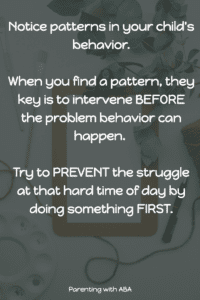Okay- so what does this have to do with Moms?
Moms are too busy to be taking data all the time! I know, don’t worry. I DO however believe that a little data can go a long way. It doesn’t even have to be formal. I won’t make you graph anything. Leave the graphing to me- I’m the BCBA who actually enjoys it!
All the strategies I’ve been sharing with you are research-based and proven to work. Does that mean you have to use them all day every day? 24/7? No. Use them when you need them? How do you know when exactly to use them? Hmmm… good question.
Identify the problem areas: hardest times of day, routines, activities, etc. You may be able to do this off the top of your head or you may need a little help from some simple data collection.
Recently, I talked about how getting out of bath and getting dressed is a hard time of day so I use the strategy of pairing my dogs who are highly reinforcing with getting dried off which can lead to tears. I knew off the top of my head that transitioning out of bath was difficult and I needed to find something to help my Little out (and save my sanity just a bit along the way!).
Are any of your everyday activities more likely to cause problem behaviors than others?
Try listing out your schedule and either just think about it (not data based, so not behavior analytic. But time-saving at least) or take data for a day or two. Just put a tally mark or check mark next to that part of the schedule when an incident of
When you find a pattern, they key is to intervene BEFORE the problem behavior can happen. Try to PREVENT the struggle at that h
ard time of day by doing something FIRST.
Ideas:
- If running errands is hard, put in a simple positive reinforcement plan. If you have good behavior (define exactly what this means: no screaming, say yes ma’am and follow directions, stay in the shopping cart), then you may have a cookie at lunch after errands. If you have problem behavior, there is no dessert. FIRST behave at the store, THEN treat.
- If bedtime is hard, change up your bedtime routine. Pair putting on pajamas and brushing teeth with music your child loves. Or save a special stuffed animal that is just for bedtime. Or try screen time if that’s your thing. We’ve successfully used the Wiggles to decrease fussiness when taking first a bottle and now a cup before bedtime.
Need more ideas? My book Parenting with Science: Behavior Analysis Saves Mom’s Sanity is available now and contains lots of research-based strategies for Moms to prevent problem behavior!
Research is cool!
Austin, J., & Carr, J. (Eds.). (2000). Handbook of applied behavior analysis. New Harbinger Publications.
Cooper, J. O., Heron, T. E., & Heward, W. L. (2007). Applied behavior analysis.
Kelly, M. B. (1977). A review of the observational data-collection and reliability procedures reported in the Journal of Applied Behavior Analysis. Journal of Applied Behavior Analysis, 10(1), 97.
Maurice, C. E., Green, G. E., & Luce, S. C. (1996). Behavioral intervention for young children with autism: A manual for parents and professionals. Pro-ed.
Recent Comments